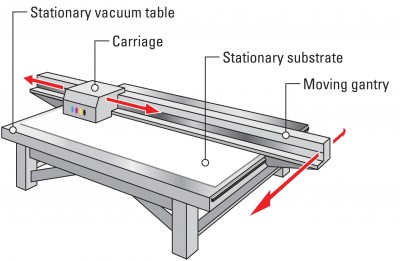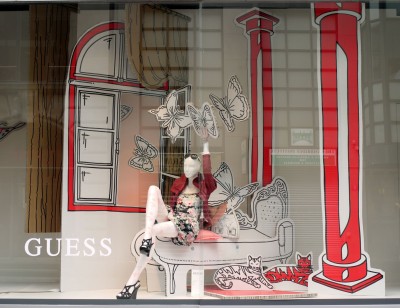
With a ‘true’ flatbed printer, the substrate is held stationary on a vacuum table while the printhead carriage and gantry move over and across it.
There are also disadvantages, however, to hybrid machines. The motion of the media can result in the misfeeding or skewing of the image, so the operator may need to intervene. Also, belt-drive systems or pinch rollers may leave marks on the print—and often require the drive system to be cleaned between prints to remove any excess ink.
Further, hybrid presses can only print on relatively light rigid media, with at least one 90-degree angle, because a corner is required to start feeding the material through the printer. Unless a customized jig is added to hold pieces in position, a hybrid press will be poor at printing on non-square or otherwise irregularly shaped items, heavy substrates and materials with an uneven surface, such as framed canvas or plywood.
True flatbed
A true flatbed printer, on the other hand, holds the substrate stationary on a vacuum table while the printing system—including the printhead carriage and gantry—moves over and across it, for the duration of the print cycle. The process is similar to screenprinting and helps ensure there is no unintentional movement of the media.
With the media held stationary through physical registration, print quality can be better optimized. Productivity is also increased through accurate, repeatable, bidirectional alignment of the piezoelectric printheads. And edge-to-edge (i.e. ‘full bleed’) printing can help reduce finishing time, as no further trimming or cutting will be required.
Double-sided prints can be handled with sufficient registration and large displays can be tiled across several boards in perfect alignment, for subsequent assembly with no discernible gaps due to skewing.
Further, multiple boards can be simultaneously printed when placed on the same vacuum table. This is particularly beneficial when producing large quantities of small signs, such as point-of-purchase (POP) graphics.
 Printhead technologies In the past, inkjet printhead manufacturers developed six-colour technology, comprising cyan, light cyan, magenta, light magenta, yellow and key/black (CcMmYK) inks. Also known as ‘super-
Printhead technologies In the past, inkjet printhead manufacturers developed six-colour technology, comprising cyan, light cyan, magenta, light magenta, yellow and key/black (CcMmYK) inks. Also known as ‘super-
CMYK,’ this ink set substitutes the lighter hues in a graphic’s highlights and quarter-tones.
This technique of tonal substitution was developed to address the inherent visual graininess of large-droplet, fixed-dot inkjet printing. The addition of the lighter colours helped create smoother, less grainy quarter- and mid-tones and gradients. Though expensive and complicated, this method became a standard over time for inkjet printers from nearly all manufacturers.
Later, progress in piezoelectric inkjet technology allowed manufacturers to start using greyscale printheads instead, which could create variable dots by jetting ink droplets in variable sizes. Rather than follow the super-CMYK model, these printheads achieve sharp images with smooth gradients by placing smaller droplets closer together, while jetting larger droplets elsewhere to create uniform, solid colours. By varying droplet sizes, digitally printed images can approach photographic quality.





